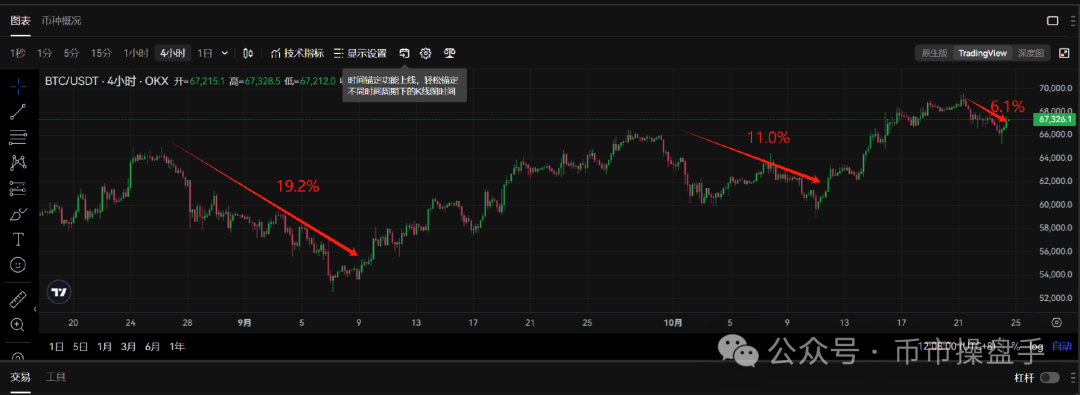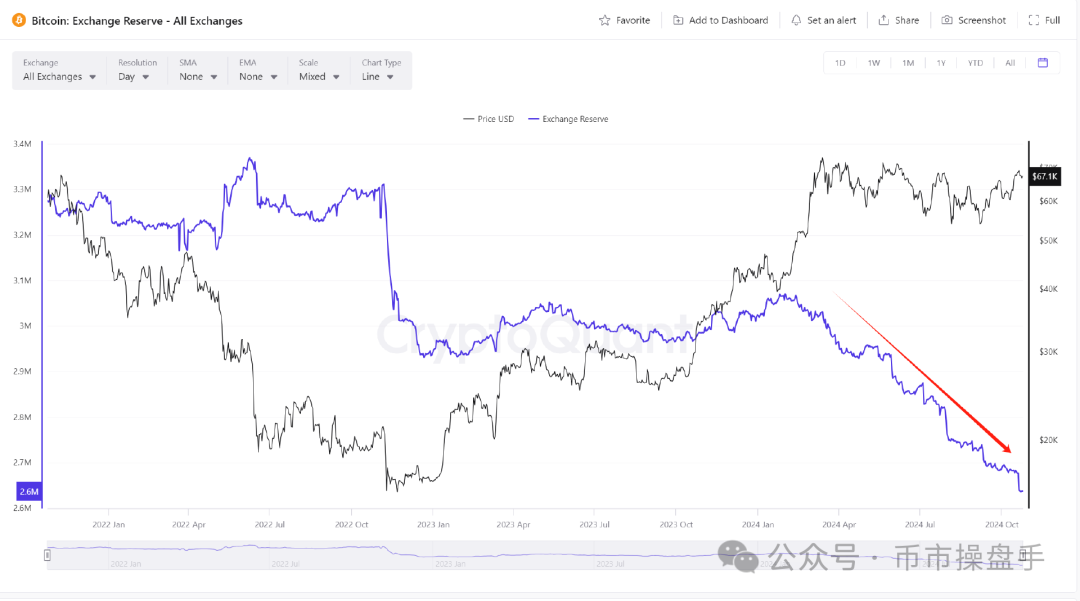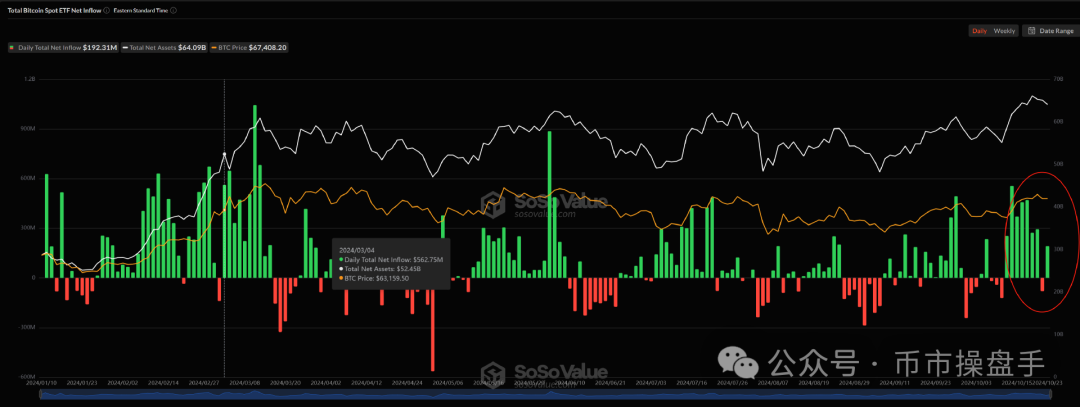Source: Coin Market Trader
After hitting resistance and falling back at $70,000, Bitcoin entered a phased adjustment. Although the market is still stalemate, judging from the 4-hour trend, the decline of each round of Bitcoin adjustment has gradually converged. According to CrytoQuant data, since the peak of $73,000, the exchange balance of Bitcoin has shown a rapid downward trend, and the supply of chips in the market has been greatly reduced. At the same time, during the adjustment of Bitcoin, funds from the US Bitcoin ETF have continued to flow in. This means that when the momentum of the short-selling is limited and the market is willing to buy at the bottom, a strong wash may cause the main force to lose chips, so they are more inclined to wash the market by "horizontal adjustment". In other words, before breaking through $73,000, the market adjustment will gradually become milder, and the wash will be achieved more by wearing out investors' patience.



Under the pattern of stock, the market of altcoins is still dominated by differentiation. Active funds continue to concentrate on MEME and new public chain fields, while most altcoins continue to fluctuate and weaken. After all, the current daily trading volume is maintained between 80 billion and 100 billion most of the time, far less than the daily average of 500 billion US dollars in 2021. This level of volume cannot support the general rise at all. In addition, the interpretation process of each bull market is complicated, extremely bumpy, and intertwined with bulls and bears, which makes it difficult for most investors to make money lying down. Taking September-October 2020 as an example, although Bitcoin continued to rise, the DeFi sector has entered the darkest moment since its birth. UNI fell from US$8.6 to US$1.7, and SUSHI fell from US$13.4 to US$0.4. The market is like ice and fire. Even after the desperate decline, the DeFi sector ushered in a violent bull market, but many investors failed to withstand the test in that round of adjustments and eventually missed the bull market feast.
In general, there is no absolute value or absolute bubble in the market, nor is there a clear distinction between large and small caps. The result of the game in the stock market is usually that most people feel uncomfortable, while a few people profit. If the increase in altcoins can achieve this effect, the altcoins will rise accordingly. Only in the middle and late stages of the bull market, when the trading volume continues to rise, can a general rise in the market be realized. For most patient capital that is fully invested and left empty, there is always a clear expectation: as long as the upward valuation space of Bitcoin opens up, most altcoins will eventually have the opportunity to catch up.
Recently, as the ETH/BTC exchange rate has fallen to a new low since the peak of the bull market in 2021, various bearish comments on Ethereum have begun to spread. The bearish views are mainly concentrated in two aspects: first, the large-scale expansion of Layer2 has produced an obvious "blood-sucking effect" on the main chain, gradually weakening the core position of the main chain; second, the rise of high-performance public chains such as Solana and SUI is constantly eroding Ethereum's market share, causing it to gradually decline.
In fact, the development direction of blockchain has always been to continuously reduce costs and increase efficiency while achieving decentralization as much as possible. The prosperity of the Layer2 ecosystem has enabled Ethereum to significantly improve its processing capacity and efficiency while maintaining security and decentralization, promoting the diversification of applications and meeting the needs of more users. This is completely in line with the core values of blockchain and is also an inevitable trend of continuous optimization and development.
First, although some Ethereum businesses have been transferred to Layer2, most Layer2 still rely on Layer1 as a data availability layer. As the activity of Layer2 transactions continues to increase, the frequency and scale of data sent back to Layer1 also increase, resulting in an increase in Ethereum GAS consumption.
Secondly, the growth of Layer2 networks has significantly increased the demand for Layer1 bridging and staking. For example, in the cross-chain process, asset locking (smart contracts) requires the consumption of Ethereum GAS. At the same time, ETH, as the most important value medium in the network, is also widely used as an economic guarantee for cross-chain mainnet verification. In addition, some bridge protocols will also record transaction data on Ethereum to ensure that the amount and status of asset transfers are in line with expectations, which will also consume Ethereum GAS.
Even if some Layer2 networks use third-party data availability layers such as Celestia to reduce costs, or change the GAS of the Layer2 network from ETH to governance tokens to increase the demand for the use of governance tokens, all transactions still need to be settled on the Ethereum mainnet. As long as it involves asset and transaction security issues, Ethereum cannot be avoided in the end.
In the Layer2 era, Ethereum plays a more decentralized role as a "central clearing bank", responsible for the security and effectiveness of all transactions in the ecosystem. As the scale of the Layer2 ecosystem continues to grow, Ethereum's network effect will be unprecedentedly enhanced, and the demand for Ethereum collateral and Ethereum GAS will explode. The current low price of the currency is still the low demand for the network. As long as a new application breakthrough is found, all difficulties can be solved.
Although the rise of high-performance public chains such as Solana and SUI has indeed eroded some of ETH's market share, Ethereum is still an unshakable overlord in the POS field. This is mainly reflected in two aspects: First, thanks to the developed Layer2 ecosystem, Ethereum has achieved expansion while maintaining a high degree of decentralization. In contrast, other public chains basically improve their expansion capabilities by sacrificing decentralization, which also leads to the security of their networks far from the level of Ethereum; second, in terms of ecological development, Ethereum's advantages are still far ahead. According to the latest data from Deflama, the current TVL of the Ethereum ecosystem (including Layer2) is 72 billion, and the scale of stablecoins is 83.6 billion US dollars. The total TVL of the Solana ecosystem, which is regarded as the "Ethereum killer", is only 7 billion US dollars (MEME coins account for more than 40%), and the scale of stablecoins is only 3.7 billion. It is almost a discontinuous lead.
For assets with obvious cyclical demand, counter-cyclical buying and selling is often the best operation strategy. Specifically, buy when Ethereum's price-to-earnings ratio (total market value/GAS revenue) and price-to-sales ratio (total market value/total on-chain transaction volume) reach their highest points, and sell when these ratios are at their lowest. Therefore, the current long-term slump in Ethereum network activity also means that a periodic buying point has appeared.












